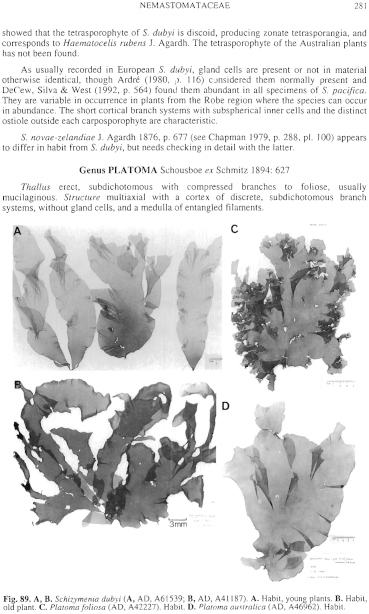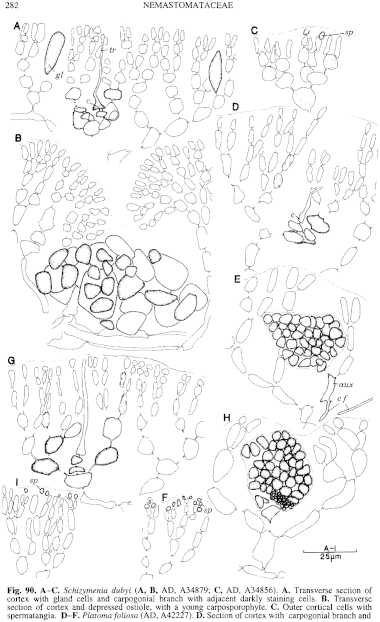|
|
|
|
|
|||||||||||
|
Electronic Flora of South Australia Species Fact Sheet
Phylum Rhodophyta – Class Florideophyceae – Order Gigartinales – Family Nemastomataceae
Selected citations: Ardré 1980: 111, pls 1–7. Dixon & Irvine 1977b: 176, fig. 62.
Thallus (Fig. 89A, B) medium to dark red-brown, mucilaginous, foliose, simple to variously and irregularly lobed, often lacerate from above (sometimes to the base), margin smooth to somewhat ruffled, 10–60 cm high and 5–15 cm broad with branches (1–) 2–10 cm broad, 300–600 (–1000) µm thick, base cuneate, usually expanding fairly abruptly from a narrow stipe. Holdfast discoid, 1–3 mm across, with one to a few fronds; epilithic. Structure of a cortex (Fig. 90A) 60–100 µm thick, of discrete branch systems (6–) 8–10 cells long, inner cells subspherical to ovoid, 6–10 (–14) µm in diameter, with tapering to elongate outermost cells 2–4 µm in diameter, L/D (1–) 1.5–2. Gland cells usually but not always present in outer cortex, ellipsoid-ovoid to clavate, 14–30 µm long and 6–10 µm in diameter, with granular contents. Medulla of moderately dense entangled filaments 3–5 (–10) µm in diameter. Rhodoplasts several per cell, discoid to elongate.
Reproduction: Sexual thalli monoecious. Carpogonial branches (Fig. 90A) 3-celled with a relatively straight trichogyne, borne on an inner cortical cell, with the supporting cell cutting off a 1–2-celled sterile row; adjacent cells staining darkly and also cutting off sterile cells. Carposporophyte (Fig. 90B) produced from an inner cortical (auxiliary?) cell, 100–240 µm across and more or less ovoid with relatively few ovoid carposporangia 15–20 µm in diameter, protruding into the medulla and with a distinct depressed ostiole through the cortex. Spermatangia (Fig. 90C) developed on outer cortex, elongate and tapering outwardly, 2–3 µm in diameter and L/D 3–4, cutting off ovoid spermatia.
Tetrasporophytes crustose, with erect filaments producing zonately divided tetrasporangia (unknown in southern Australia).
Type from Cherbourg, France; lectotype in STR.
Selected specimens: Fremantle, W. Aust., drift (Kraft & Herrington, 2.ix.1990; MELU, 40353). Pondalowie Bay, S. Aust., drift (Womersley, 24.iv.1955; AD, A19881). Vivonne Bay, Kangaroo I., S. Aust., 0–5 m deep on jetty piles (Kraft & Min-Thein, 4.xii.1971; AD, A41400). Robe, S. Aust., drift (Womersley, 11.xii.1969; AD, A34879) and 0.5–1 m deep, shaded, in bay (Womersley, 19.xii.1971; AD, A41187 -"Marine Algae of southern Australia" No. 355). Cape Lannes, S. Aust., shaded upper sublittoral pool (Womersley, 14.v.1972; AD, A42391 -"Marine Algae of southern Australia" No. 355a and 7.xii.1991; AD, A61539 -"Marine Algae of southern Australia" No. 355b). 1.3 km off Cape Northumberland, S. Aust., 15 m deep (Shepherd, 26.x.1977; AD, A55113). Warrnambool, Vic., drift (G. & R. Kraft & Saunders, 29.xi.1991; MELU, 40389). Bridgewater Bay, Vic., drift (Womersley, 14.iv.1959; AD, A22623). Point Lonsdale, Vic., drift (Womersley, 10.xii.1969; AD, A34856). Taroona, Tas., uppermost sublittoral (Sanderson, 24.xi.1991; AD, A61526).
Distribution: Europe, Mediterranean, Japan.
In southern Australia, Fremantle, W. Aust., and Pondalowie Bay, S. Aust., to Point Lonsdale, Vic.
Taxonomic notes: Turne rella atlantica Kylin 1930: 40, figs 27,28.
The Australian material agrees well with Schizymenia dubyi from Porto (Portugal) in Hauck & Richter "Phykotheka universalis" No. 309, and is very similar to the description of Ardré (1980) of the type species; although the full details of the sexual reproduction in Australian specimens have not been followed, stages observed are closely comparable. Ardré showed that the tetrasporophyte of S. dubyi is discoid, producing zonate tetrasporangia, and corresponds to Haematocelis rubens J. Agardh. The tetrasporophyte of the Australian plants has not been found.
As usually recorded in European S. dubyi, gland cells are present or not in material otherwise identical, though Ardré (1980, p. 116) considered them normally present and DeCew, Silva & West (1992, p. 564) found them abundant in all specimens of S. pacifica. They are variable in occurrence in plants from the Robe region where the species can occur in abundance. The short cortical branch systems with subspherical inner cells and the distinct ostiole outside each carposporophyte are characteristic.
S. novae-zelandiae J. Agardh 1876, p. 677 (see Chapman 1979, p. 288, pl. 100) appears to differ in habit from S. dubyi, but needs checking in detail with the latter.
References:
AGARDH, J.G. (1851). Species Genera et Ordines Algarum. Vol. 2, Part 1, 1–336 + index. (Gleerup: Lund.)
AGARDH, J.G. (1876). Species Genera et Ordines Algarum. Vol. 3, Part 1 - Epicrisis systematis Floridearum, pp. i-vii, 1–724. (Weigel: Leipzig.)
ARDRÉ, F. (1980). Observations sur le cycle de développement du Schizymenia dubyi (Rhodophycée, Gigartinale) en culture, et remarques sur certains genres de Némastomacées. Cryptogamie, Algol. 1, 111–140.
CHAPMAN, V.J. (1979). The marine algae of New Zealand. Part DI Rhodophyceae. Issue 4: Gigartinales. (Cramer: Germany.)
DECEW, T.C., SILVA, P.C. & WEST, J.A. (1992). Culture studies on the relationship between Schizymenia and Haematocelis (Gigartinales, Rhodophyceae) from the Pacific coast of North America. J. Phycol. 28, 558–566.
DIXON, P.S. & IRVINE, L.M. (1977b). Seaweeds of the British Isles. Vol. 1, Rhodophyta. Part I, Introduction, Nemaliales, Gigartinales. [British Museum (N.H.): London.]
KYLIN, H. (1930). über die entwicklungsgeschichte der Florideen. Lunds Univ. Årsskr. N.F. Avd. 2, 26 (6), 1–104.
The Marine Benthic Flora of Southern Australia Part IIIA complete list of references.
Publication:
Womersley, H.B.S. (14 January, 1994)
The Marine Benthic Flora of Southern Australia
Rhodophyta. Part IIIA, Bangiophyceae and Florideophyceae (to Gigartinales)
Reproduced with permission from The Marine Benthic Flora of Southern Australia Part IIIA 1994, by H.B.S. Womersley. Australian Biological Resources Study, Canberra. Copyright Commonwealth of Australia.
Illustrations in Womersley Part IIIA, 1994: FIGS 89A, B, 90 A–C.

Figure 89 enlarge
Fig. 89. A, B. Schizymenia dubyi (A, AD, A61539; B, AD, A41187). A. Habit, young plants. B. Habit, old plant. C. Platoma foliosa (AD, A42227). Habit. D. Platoma australica (AD, A46962). Habit.

Figure 90 enlarge
Fig. 90. A–C. Schizymenia dubyi (A, B, AD, A34879; C, AD, A34856). A. Transverse section of cortex with gland cells and carpogonial branch with adjacent darkly staining cells. B. Transverse section of cortex and depressed ostiole, with a young carposporophyte. C. Outer cortical cells with spermatangia. D–F. Platoma foliosa (AD, A42227). D. Section of cortex with carpogonial branch and adjacent darkly staining cells. E. Cortex with auxiliary cell and connecting filament, and carposporophyte. F. Outer cortex with spermatangia. G–I. Platoma australica (G, AD, A46962; H, I, AD, A45120). G. Transverse section of cortex with a carpogonial branch and adjacent darkly staining cells (two cells with rhodoplasts). H. Carposporophyte. I. Outer cortex with spermatangia.

|
Email Contact: State Herbarium of South Australia |

|